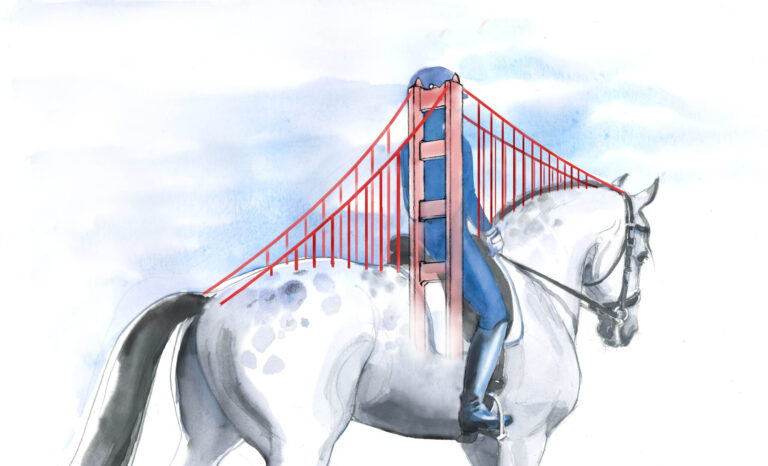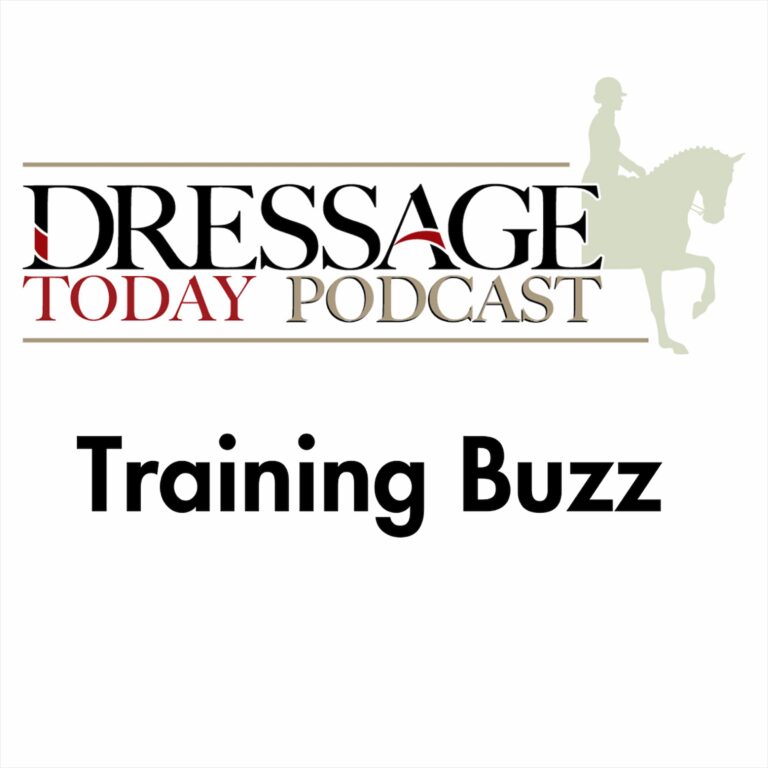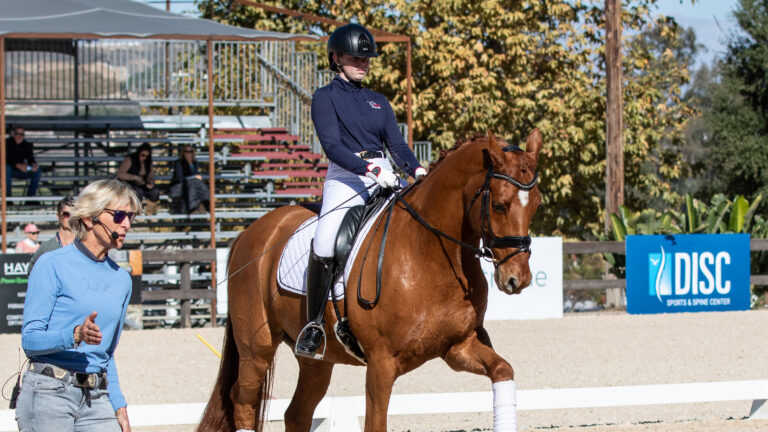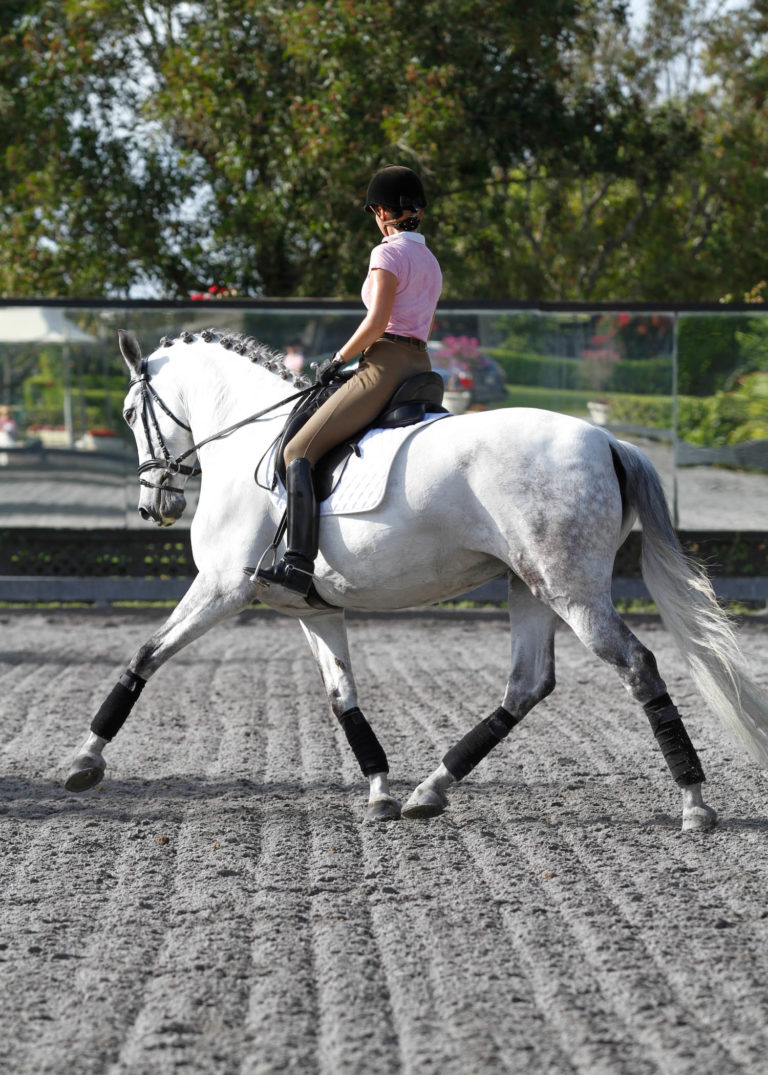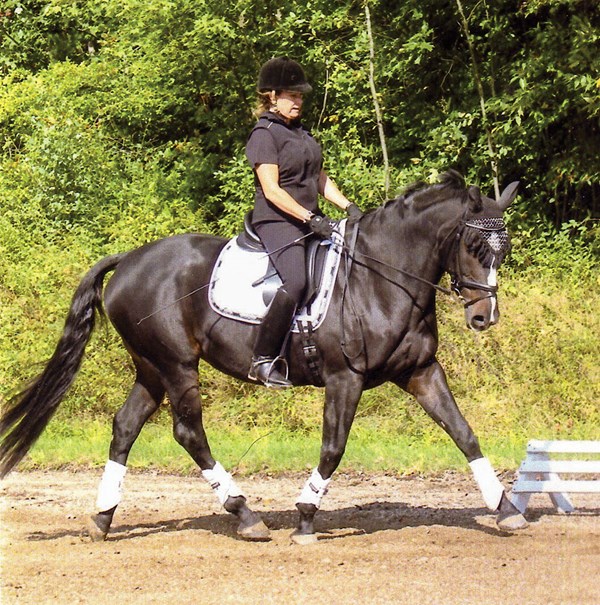
This picture shows Lynne Simonson riding her 11-year-old Dutch/Thoroughbred-cross mare, Teaghan, in a clinic. She has shown successfully at Training and First Level. Teaghan shows an uphill, forward trot with good reach from the legs. She looks active and dynamic while she stays focused and concentrated on her rider.
Lynne is riding with the same concentration, but she needs to be careful not to look down and overconcentrate. This happens easily, especially in a clinic situation, when a rider is wanting to ride at her best while taking in a mass of new input. The outline of Lynne’s seat is correct, but I would like to see her carry her hands a little higher while riding with her leg a bit longer and more relaxed. However, I recognize that in this moment, she may just be asking for a little more, using her inside leg, and a second later her leg could be nicely relaxed again.
I do like how the horse is responding to her and steps under with her inside hind leg and, as a result, her shoulder becomes more free to reach forward. I particularly like Lynne’s upper-body position, as she carries her chest upright without becoming tense and her shoulders are nice and soft at her sides. Yet the whole picture for me lacks some lightness and looks like both horse and rider are working a bit too hard. I would like this pair to look more effortless. Again, given the information that this is a picture taken during a clinic, this isn’t necessarily negative. When a horse and rider are learning something new, the effort always involves a little more tension, as it is not yet possible to perform new skills with ease and lightness. Ease and lightness are only possible once skills are mastered.
I get the impression that Lynne and Teaghan have worked on improving the quality of the trot and opening the stride to create a more uphill movement. As this is a new feeling for both of them, both appear a little tense and uncertain. Lynne shows a bit too much tension in her leg and is concentrating, looking down. Teaghan responds nicely behind and opens her stride from her shoulder, but her topline does not lengthen together with her legs yet. In the picture, Teaghan’s front hoof is in front of her nose. Ideally, she will learn to support her movements more through her back. As she stretches through her whole topline, her neck and nose will be able to reach out as far as her legs, too. When this happens, I am positive that the picture of the pair will show more lightness.
One of my instructors once told me, if I want to learn and improve I have to get out of my comfort zone. And if I stop riding politely my horse may stop moving politely. He was right. In the next few years, this horse developed beyond my expectations. And sure enough, learning is not possible without making some mistakes, too. To find the right balance of how much to ask and how much to give requires the experience of having done too much or too little.
To practice more awareness and to refine the interplay of your aids, try this: Establish a trot that you can call your “comfort-zone trot,” where minimum effort is needed to maintain activity and balance. Then ask for a little more for a few strides and return to the comfort zone. It is important that the horse reacts but is able to return to a place of comfort quickly. The goal is to become more aware about the comfort zone and to maintain lightness within the aids when asking to leave it. A training method called working “sub-maximally” asks only for short peaks out of the comfort zone. This will actually improve and change you and your horse’s comfort zone, so that the horse works comfortably on a higher-quality level. This also affects overall suppleness, as true suppleness means the body is free to move in a balanced way in all directions: to extend and collect any time and to feel the collection within the extension and the extension within the collection.
I am sure Lynne will be able to improve and push her and Teaghan’s comfort zone to a higher level of quality and together they can enjoy their journey up the levels.
Susanne von Dietze is a leader in equestrian biomechanics. A physiotherapist, licensed Trainer A instructor and judge for dressage and show jumping, she gives lectures and seminars throughout the world, including at the prestigious German Riding Academy in Warendorf. She is a native of Germany and now lives with her husband and three children in Israel, where she competes at the international level. She is the author of two books on the biomechanics of riding: Balance in Movement and Horse and Rider, Back to Back. Find her books at HorseBooksEtc.com.


